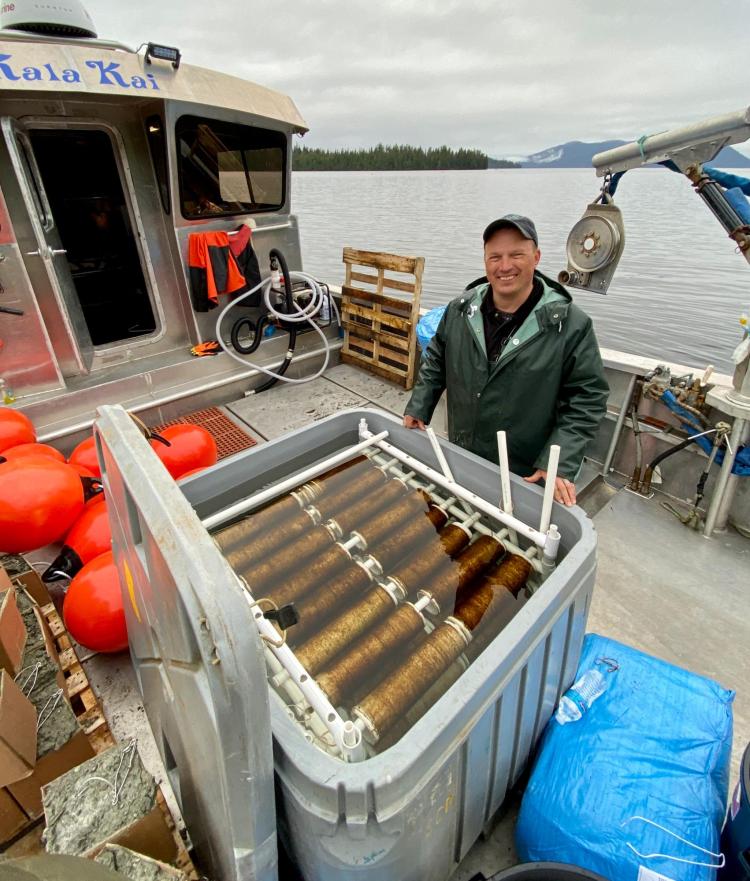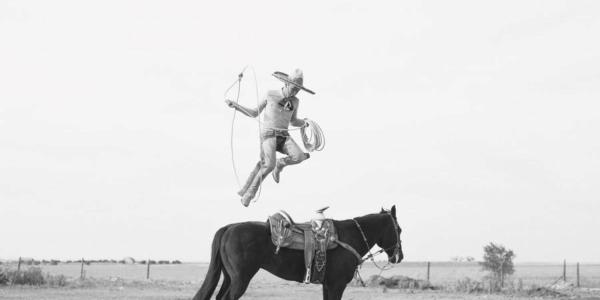With help from Nat Geo, CU Boulder alumnus Markos Scheer expands kelp farm to include oysters, and he touts the economic and environmental benefits of the venture
University of Colorado Boulder alumnus Markos Scheer (PoliSci’90) has gotten a lot of interest in his farming operation since planting his first crop in 2019.
That has included the folks at Nat Geo’s “Farm Dreams” TV show, which in early 2022 sent show host Indy Officinalis to check it out. To inspect his farm up close, Scheer had Officinalis join him on his boat, which transported them to Doyle Bay, off the west coast of Prince of Wales Island, in southeast Alaska. Once there, Officinalis donned a wetsuit so she could go beneath the surface of the frigid waters to see his crop for herself.
Scheer is the founder and CEO of Premium Aquatics, doing business as Seagrove, a mariculture development operation, which involves the cultivation of marine life in enclosed sections of open water. More specifically, Scheer is a kelp and oyster farmer whose crops grow in the pristine waters of southeast Alaska.
“Kelp farming simultaneously shares characteristics with farming (on land) while also being very different,” Scheer explains. For one thing, Scheer’s kelp seedlings start off in a nursery. Once they are ready to be “planted,” the seedlings are string-spooled around sections of PVC, which are planted on horizontal ropes suspended from catenaries and suspended in the ocean, so that they get the right amount of sunlight and nutrients. The lines are laid in October, November and December, and harvesting typically occurs in May.

University of Colorado Boulder alumnus and Alaska native Markos Scheer founded Seagrove with the intent of creating a business that is sustainable while creating job opportunities for Alaskans in coastal communities. He is pictured next to spools of kelp waiting to be “planted” in the Alaskan waters.
Kelp is remarkably fast-growing—some species grow up to 1 foot per day—and kelp cultivation in the ocean requires no added nutrients or pesticides like land-based agriculture. What’s more, kelp typically requires very little maintenance between planting and harvesting.
When Nat Geo’s Officinalis toured Scheer’s farm, she was impressed with the operation and enjoyed sampling some of his raw produce, which she described as tasting like a “potato chip from the sea.”
Coincidentally, Scheer says many of his clients are food companies that refine his kelp into their products—including kelp chips.
“There are a number of companies that use our kelp in their snack products, including 12 Tides, which makes kelp chips that are sold in Whole Foods stores. They have been a great customer of ours,” he says. Companies that use kelp in their products tout it as being low in fat and calories while being rich in nutrients.
Diversifying the farm’s operations
Officinalis praised Scheer’s kelp farm operation, and she also offered two suggestions: that Scheer actively market his kelp to companies beyond those making edible foods, and that the business diversify its operations by expanding into the cultivation and sale of oysters. Toward that goal, Nat Geo gave Scheer about 1,000 young oysters and special cages to house them that float in the water near the kelp farm’s existing operations.
“I thought it was a really great opportunity to talk about what we’re doing and the positives of what we’re doing,” Scheer says of being on the show, adding that he also appreciated the suggestions, toward which he was already working. Specifically, when he obtained permits from the state of Alaska to launch his 127-acre mariculture operation, about 27 of those acres were originally allocated for cultivating shellfish.
“The 1,000 oysters that Nat Geo gave us were part of a testing protocol to develop the second phase of this operation, which was a shellfish operation,” he says. “The ones we put in the water during the show were about the size of a big fingernail—and those oysters are now 3 to 4 inches long and have done very well.”
After proving oyster farming is viable, Scheer says he was able to secure more funding earlier this year to dramatically grow that part of the business.
“We currently have about 2 million oysters in the water, and we may have another half-million or so before the end of (the year),” he says. All those oysters are in special floating cages that prevent the accumulation of grit on the shells and are ideally suited for growing healthy oysters. The first oysters from this new business venture should be ready for harvesting in July, he adds.

Markos Scheer's crops include various types of sea kelp.
Meanwhile, Scheer says the company plans to build a new production facility in Ketchikan, Alaska, to house an automated sorting and cleaning system for processing harvested oysters. Once the system is up and running, it will be able to process several thousand oysters a day, he says.
Scheer says he also continues to look for new market opportunities for the company’s kelp. Along those lines, he is looking to purchase a machine that will dry harvested kelp on a large scale, so it can be turned into useful non-food products, such as fertilizer.
“During our best year, which was 2022, we harvested about 175 tons of kelp, which I’m certain is the largest single-site harvest in the country,” Scheer says. “I’m confident we can produce even more. We just haven’t yet, until we have the infrastructure in place to catch up with our ability to produce it.”
Why Alaska? Why mariculture?
Giving something back to the Alaskan communities where he was reared is deeply personal work for Scheer. He spent his formative years working at seafood-processing plants before attending CU Boulder to earn a political science degree and, later, a law degree from the University of Idaho.
Even after he became an attorney in Seattle, his ties to Alaska remained, as his law practice focused on maritime law related to the seafood industry. He also served on several Alaska-based advisory groups that promoted the development of mariculture in the state.
Scheer says he initially envisioned his role in promoting Alaskan mariculture as more advisory, including his work as a board member of the Alaska Fisheries Development Foundation, but he ultimately realized he needed to play a more hands-on role.
“We were saying, ‘Let’s get the fishing industry to invest in this and take the lead,’ but it wasn’t really getting the traction we’d all hoped for,” Scheer says. “And at that point I thought, ‘Well, be the change you want to see.’”
It took several years to acquire funding, obtain regulatory approvals from various state and federal government agencies to build the mariculture farm, launch the kelp nursery and begin overall operations, he says.

Markos Scheer's farming operation has expanded to include oysters, which grow in special cages that float in the water, and which are suited for growing healthy oysters.
He’s pleased with his company’s growth in a few years—but says he’s even more pleased that the business is environmentally friendly and is providing a growing number of jobs for coastal Alaskans, who often rely on seasonal work for their livelihoods, including working as crew on fishing vessels.
“So much of Alaska’s economic activity since colonization has been focused on the extraction of natural resources and taking those to market, whether it be furs, gold, timber, mining, fishing or oil,” Scheer says.
“What we’re looking to do here is a real paradigm shift, because we grow something that is indigenous, and it is non-extractive; it is sustainable; it is renewable. The benefits of seaweed and shellfish farming are very well-established—for example, taking carbon and nitrogen out of the water.
“But farming is also intensely local—it has to be done by the people who live here. It is very community-centric. So, I look at this as an opportunity to do economic development at the local level. And the skills that are necessary to do this kind of work (harvesting) are something that people who grew up in coastal communities, growing up on boats and working on the water, they know how to run boats and do it safely.”
Premium Aquatics employs about a dozen people, including a mix of full-time and part-time employees. Full-time employees tend to work in administration, at the kelp nursery in Ketchikan, and in the oyster farm off Prince of Wales Island, near Craig, Alaska, monitoring the oysters and harvesting kelp during the harvest season.
However, when the oyster-processing facility in Ketchikan opens, Scheer says he expects it to create an additional seven to 10 full-time jobs, and there are likely to be more opportunities for full- and part-time work as the kelp and oyster operation grows.
What’s more, he says he hopes he has developed a business model that other Alaskan coastal communities can adopt to create jobs in their own regions.
“There’s just so many positives about this,” Scheer says of his mariculture operation. “We don’t have very many opportunities in our lives, most of us, to affect real, positive change that will persist long after we’re in the dirt. This is one of those. This is one of those times where I really believe that this potential is tremendous and meaningful.”
Top image: Markos Scheer's kelp farming operation in Doyle Bay off the coast of Prince of Wales Island in southeast Alaska
Did you enjoy this article? Subcribe to our newsletter. Passionate about alumni achievement? Show your support.



